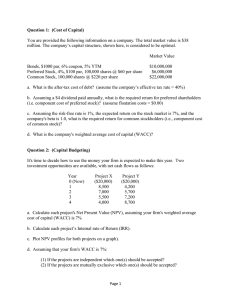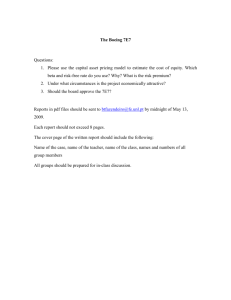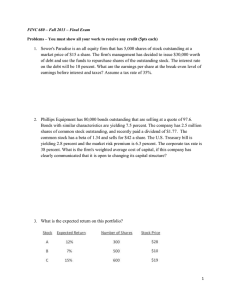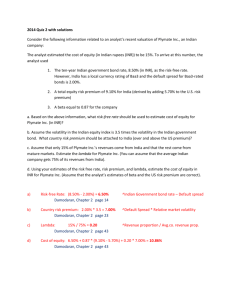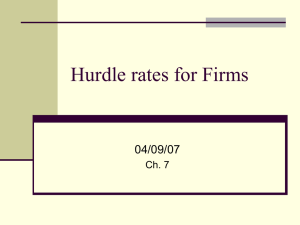Hurdle rates for Firms (part 1)
advertisement
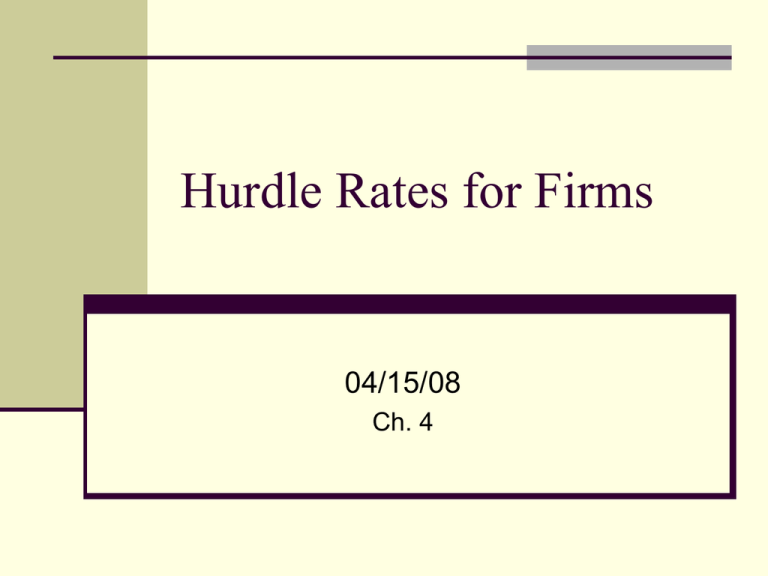
Hurdle Rates for Firms 04/15/08 Ch. 4 Investment Decision Firms should invest in projects that create value for the firm’s shareholders These are projects that yield a return greater than the minimum acceptable hurdle rate with adjustments for project riskiness. Do you ever lend money and expect to get less back? Companies should not… 2 Investment Decision Components of the investment decision making process Determine the appropriate hurdle rate for the firm (Ch. 4) -- WACC Make adjustments for project riskiness (Ch. 5) Calculate the cash flows associated with the project – Incremental Cash Flow Employ the appropriate decision tools -- NPV Evaluate project interactions (Ch.6) If NPV is positive go, if NPV is negative no-go 3 What is a Hurdle Rate? The hurdle rate for the firm represents the minimum rate of return that the firm as a whole must generate on its investments to satisfy its investors. It is the implicit cost of money for the firm… This is also referred to as the weighted average cost of capital (WACC) or simply the cost of capital. 4 Weighted Average Cost of Capital Percent of financing times the cost of financing for that funding source Sources Equity (Owners) Debt (Bondholders, Banks, etc.) Preferred Stockholders (often skipped) WACC = (E/V) x Re + (D/V) x Rd x (1 – Tc) 5 Cost of Equity Required rate of return for equity investors (or shareholders) is also referred to as the cost of equity For publicly traded firms, we initially assume that the these equity investors are diversified investors. Consequently, Only the firm’s risk relative to the market is relevant (systematic risk) Firm-specific risk is assumed to be diversified away re rf (rm rf ) 6 Cost of Equity To calculate the cost of equity for a firm, we need estimates for each of its components: Risk-free rate, rf Market return, or alternatively the market risk premium, (rm- rf) Firm’s beta, β 7 Risk-free Rate With the risk-free asset, the actual return and expected return do not vary. The risk-free asset assumes: No default risk (bonds and their ratings) No reinvestment risk (coupons reinvested) Ideally, this means that you should use a risk- free asset whose maturity matches the timing of cash flows Treasury securities http://screen.yahoo.com/bonds.html 8 Market Risk Premium The market risk premium represents the extra return beyond that of a risk-free asset that an investor demands for moving their funds from the risk-free asset to the risky (market portfolio) asset. E(rm) – rf = market risk premium… Consider this payment for units of risk Beta as units of risk Increase Beta and you increase demand for extra risk premium 9 Estimating the Market Risk Premium There are two methods to estimate the market risk premium. historical risk premium Implied risk premium The majority of analyses tend to employ the historical method or some form of weighted average between the two. 10 The Historical Approach In most cases, historical market risk premiums can be estimated as follows: define a time period for the estimation (1926Present, 1962-Present....) Arithmetic average (simple average)…Find each year’s return, then average of the yearly returns Geometric average (compounding)… Take the difference between the average return of the market and the risk-free rate Look at Finance. Yahoo (ticker SPY) ‘93 to now 11 Historical Premium Limitations The limitations of this approach are: it assumes that the risk aversion of investors has not changed in a systematic way across time. (The risk aversion may change from year to year, but it reverts back to historical averages) it assumes that the riskiness of the “risky” portfolio (stock index) has not changed in a systematic way across time 12 Implied Premium Approach The implied risk premium approach estimates a risk premium based on current market values, dividends and growth rates. We can use a basic dividend discount model (DDM) to estimate the implied risk premium: Index value = Expected index dividends (RR on the index – growth rate in dividends) The implied risk premium would then be: RR on index – current risk-free rate 13 Implied Premium Limitations The limitations of this approach are: It assumes that the DDM is correct to value the market. It assumes that the market is currently correctly valued (what other choice do we have?) If the market is not correctly valued how do we adjust for the errors of the many? Would we even care to estimate the correct value or would we “exploit” this error of the many? 14 Looking at Beta Co-movement with the market (regression) Estimated with stock returns of the individual company as the dependent variable Return = [(PriceT+! + Dividends)/ PriceT] – 1 Why add dividends to price? Independent variable is usually large market index S&P 500 is very popular Return of S&P 500, should add in dividends 15 Regression to Find Beta Independent Variable is Market Return Dependent Variable is Individual Stock Return Regression estimates slope and intercept Slope, beta = Covariance (y, x) / Variance of X Intercept, alpha = mean (y) – beta x mean (x) R2 = (beta times variance of x) / variance (y) Problem #12 – AnaDome Beta 0.735, intercept -0.0015, R-squared 0.29 16 Issues with Beta Estimation Time period of returns Longer periods provide more data Longer periods introduce problems with shifts in the beta of the company (all firms moving to a beta of 1?) What is the right return interval? Daily, Monthly, Quarterly, Annual…more data better What is the Market Return? What do you use for the market? Should be all assets…we use S&P 500 for US stocks and we are “happy” 17 Bottom-up betas The bottom-up approach relies on the fundamental characteristics of the firm to determine the riskiness of the firm and thus the firm beta. These fundamental characteristics include: Type of Business: Firms in more cyclical businesses or that sell products that are more discretionary to their customers will have higher betas than firms that are in non-cyclical businesses or sell products that are necessities or staples. Operating Leverage: Firms with greater fixed costs (as a proportion of total costs) will have higher betas than firms with lower fixed costs (as a proportion of total costs) Financial Leverage: Firms that borrow more (higher debt, relative to equity) will have higher betas than firms that borrow less. 18 Bottom-up betas The first component of a firm’s risk is that associated with its operations: We can measure this risk by calculating the firm’s unlevered beta (βU), i.e., a beta that removes the effect of financial leverage. This unlevered beta is also referred to as an asset beta as it represents the riskiness of a firm’s assets. βU = Current Beta / (1+(1-TC)(D/E)) 19 Equity Betas and Leverage The following equation provides us with the mathematical relationship between the unlevered and levered beta: u L 1 1 TC D / E where L = Levered Beta u = Unlevered Beta t = Corporate marginal tax rate D = Debt Value E = Equity Value 20 Cost of Equity Once we know Risk-free Rate Market Premium Beta of the firm… Calculate the Cost of Equity re rf (rm rf ) 21 What is debt? General Rule: Debt generally has the following characteristics: Commitment to make fixed payments in the future The fixed payments are tax deductible Failure to make the payments can lead to either default or loss of control of the firm to the party to whom payments are due. As a consequence, debt should include Any interest-bearing liability, whether short term or long term. Any lease obligation, whether operating or capital. 22 Cost of debt vs. required rate of return for debtholders The required rate of return for bondholders of a particular firm is a function of: Current interest rate for the risk-free asset Default risk associated with the firm, i.e., how likely is the firm to go bankrupt (risk premium). Bondholders are compensated in interest payments (or coupon payments) for this required rate of return. Because from the firm’s perspective interest expense is tax-deductible, the after-tax cost of debt (rd) is: rd * (1 – tax rate) 23 Estimating the cost of debt Depending on whether or not the firm in question has bonds that are publicly traded and on available information, there are three ways (in order of preference) to estimate the before-tax cost of debt: Look for prices and yields of bonds outstanding Estimate the cost of debt from the firm’s credit rating Estimate the cost of debt by calculating a synthetic credit rating 24 Estimating the cost of debt If the firm has bonds outstanding, and the bonds are traded, the yield to maturity (YTM) on a long-term, straight (no special features) bond can be used as the before tax cost of debt. http://screen.yahoo.com/bonds.html FV P N 1 YTM 1 1 N 1 YTM Coupon YTM 25 Estimating the cost of debt If the firm is rated, use the credit rating and a typical default spread on bonds with that rating to estimate the cost of debt. See page 139 of text for default spreads by rating Start again with risk-free rate and add default spread 26 Back to WACC Once we know the required return for equity and debt And we know the percentage of each funding And we know the tax rate… We can estimate the hurdle rate by calculating the WACC (E/V) x Re + (D/V) x Rd x (1 – Tc) Note…the riskiness of the cash flows will be implied by beta and the bond rating 27 Homework Chapter 4 - 5, 8, 9, 14, 19, and 23 28


